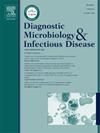Infection in glaucoma drainage implant caused by macrolide-resistant Mycobacterium abscessus subsp. abscessus
IF 1.8
4区 医学
Q3 INFECTIOUS DISEASES
Diagnostic microbiology and infectious disease
Pub Date : 2025-08-14
DOI:10.1016/j.diagmicrobio.2025.117060
引用次数: 0
Abstract
We report a rare case of Mycobacterium abscessus infection following Ahmed glaucoma valve (AGV) implantation in a 74-year-old immunocompetent man with exfoliative glaucoma. He developed conjunctival dehiscence and aqueous leakage, requiring AGV removal and re-implantation in a different quadrant. On postoperative day 27, purulent discharge appeared, prompting emergency explantation. M. abscessus subsp. abscessus was identified by culture and multiplex polymerase chain reaction, which detected the inducible macrolide resistance gene erm(41). Initial intravenous and oral multidrug therapy was discontinued due to patient preference. Infection recurred, requiring surgical debridement and prolonged therapy with amikacin, clofazimine, and sitafloxacin based on susceptibility results. This case underscores the diagnostic and therapeutic challenges of AGV-associated M. abscessus infection, which may occur in immunocompetent hosts. The organism’s ability to form biofilms and resist multiple antimicrobials—especially through inducible macrolide resistance—complicates treatment. Early removal of infected devices and susceptibility-guided antimicrobial selection are essential for infection control.
耐大环内酯脓肿分枝杆菌引起青光眼引流植入物感染。脓肿
我们报告一例罕见的脓肿分枝杆菌感染后,艾哈迈德青光眼瓣膜(AGV)植入术在一个74岁的免疫功能正常的男子剥脱性青光眼。他出现结膜开裂和水漏,需要移除AGV并在另一个象限重新植入。术后第27天出现脓性分泌物,促使紧急摘除。脓肿支原体通过培养和多重聚合酶链反应对脓肿进行鉴定,检测到诱导型大环内酯类耐药基因erm(41)。最初的静脉和口服多药治疗因患者偏好而停止。感染复发,需要手术清创,并根据敏感性结果延长阿米卡星、氯法齐明和西他沙星的治疗。该病例强调了agv相关脓肿分枝杆菌感染的诊断和治疗挑战,这种感染可能发生在免疫功能正常的宿主中。生物体形成生物膜和抵抗多种抗菌剂的能力——特别是通过诱导大环内酯类药物的耐药性——使治疗复杂化。早期移除受感染的器械和以敏感性为导向的抗菌药物选择对感染控制至关重要。
本文章由计算机程序翻译,如有差异,请以英文原文为准。
求助全文
约1分钟内获得全文
求助全文
来源期刊
CiteScore
5.30
自引率
3.40%
发文量
149
审稿时长
56 days
期刊介绍:
Diagnostic Microbiology and Infectious Disease keeps you informed of the latest developments in clinical microbiology and the diagnosis and treatment of infectious diseases. Packed with rigorously peer-reviewed articles and studies in bacteriology, immunology, immunoserology, infectious diseases, mycology, parasitology, and virology, the journal examines new procedures, unusual cases, controversial issues, and important new literature. Diagnostic Microbiology and Infectious Disease distinguished independent editorial board, consisting of experts from many medical specialties, ensures you extensive and authoritative coverage.

 求助内容:
求助内容: 应助结果提醒方式:
应助结果提醒方式:


